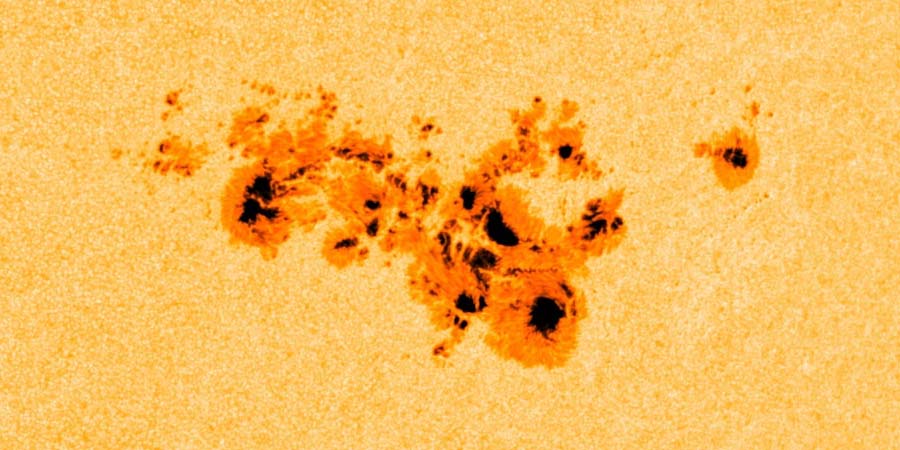Severe G4 geomagnetic storm watch
Thursday, 9 May 2024 18:34 UTC

Sunspot region 3664 which is easily the most complex sunspot region of the current Solar Cycle thus far continues where it left of yesterday, producing countless of M-class solar flares today and three X-class events (X1.0, X2.2 and X1.1). It remains an extremely complex sunspot region which has the potential to produce more major solar flares, perhaps even exceeding X5 or even X10.
Since our news article that we posted yesterday we had two more coronal mass ejections (from the X1.0 and X2.2 events) that have a very clear asymmetrical full halo outline. Below you can find an animation of these two CMEs coming from the SOHO/LASCO C2 coronagraph. We wont go into detail on all of the flares as that would mean I would be sitting here typing until midnight but both of the coronal mass ejections launched by the X1.0 and X2.2 solar flares have high probability to arrive at Earth.
Sunspot region 3664 remains very active and since our last update two more earth-directed coronal mass ejections were launched. One from an X1.0 flare and one from an X2.2 flare. The CMEs can be seen on the animations from SOHO/LASCO below.
— SpaceWeatherLive (@_SpaceWeather_) May 9, 2024
This means four CMEs are likely to… pic.twitter.com/owNxjKMx7Y
This means that there are four, yes four separate coronal mass ejections currently on their way to Earth. The first of these coronal mass ejections will likely arrive in about 24 to 36 hours from now (late on 10 May or early on 11 May). This impact will likely be followed by three more coronal mass ejection arrivals on 11 and 12 May.
This means we are in for a period with very high geomagnetic activity, where geomagnetic storm conditions are possible over multiple days. In response to the four anticipated coronal mass ejection arrives, the NOAA SWPC has issued a severe G4 geomagnetic storm watch for 11 May which yes indeed equal a Kp of 8. This could indeed be an amazing opportunity for sky watchers at middle latitude or maybe even low latitude locations to capture a glimpse of the aurora from places that normally do not get to see them. Under optimal conditions we might get to see aurora from latitudes as low as San Francisco (CA, United States) Dallas (TX) Atlanta (GA) and in Europe perhaps even northern France and southern Germany get a chance to see aurora. Like everything space weather related, nothing is a guarantee but all the ingredients are there that we might be in for some spectacular space weather here at Earth in the days ahead. Be sure to follow the data right here on the SpaceWeatherLive website or our Android/iOS app.
X1.1 solar flare
While we were writing this article, sunspot region 3664 produced yet another X-class solar flare. This time peaking at X1.1 at 17:43 UTC. It is still too early to analyze this event but it also looks eruptive based on preliminary SDO footage. If this event also launched a coronal mass ejection with an earth-directed component, that would mean there are five coronal mass ejections on their way to our planet. We will update tomorrow with additional information. For now... goodnight and charge those camera batteries!
Thank you for reading this article! Did you have any trouble with the technical terms used in this article? Our help section is the place to be where you can find in-depth articles, a FAQ and a list with common abbreviations. Still puzzled? Just post on our forum where we will help you the best we can!
Latest news
Latest forum messages
Support SpaceWeatherLive.com!
A lot of people come to SpaceWeatherLive to follow the Sun's activity or if there is aurora to be seen, but with more traffic comes higher server costs. Consider a donation if you enjoy SpaceWeatherLive so we can keep the website online!

Space weather facts
| Last X-flare | 2025/03/28 | X1.1 |
| Last M-flare | 2025/04/18 | M4.4 |
| Last geomagnetic storm | 2025/04/16 | Kp8- (G4) |
| Spotless days | |
|---|---|
| Last spotless day | 2022/06/08 |
| Monthly mean Sunspot Number | |
|---|---|
| March 2025 | 134.2 -20.4 |
| April 2025 | 120.5 -13.7 |
| Last 30 days | 116.6 -25.7 |


